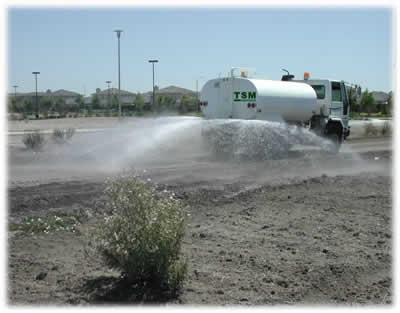Dust Control

Description
Reducing surface and air movement of dust from exposed soil surfaces during land disturbing, demolition, and construction activities.
Where Practice Applies
On construction routes and other disturbed areas subject to surface dust movement and dust blowing where on-site and off-site damage is likely to occur if preventive measures are not taken.
Advantages
A decrease in the amount of dust in the air will decrease the potential for accidents and respiratory problems.
Disadvantages/Problems
Excessive use of water to control dust emissions, particularly in areas where the soil has been compacted, can cause a runoff problem.
Planning Considerations
- Large quantities of dust can be generated during land grading activities for commercial, industrial, or subdivision development, especially during dry, windy weather. Research at construction sites has established an average dust emission rate of 1.2 tons/acre/month for active construction. Earthmoving activities comprise the major source of construction dust emissions, but traffic and general disturbance of the soil also generate significant dust emissions.
- In planning for dust control, it is important to schedule construction activities so that the least area of disturbed soil is exposed at one time.
- For disturbed areas not subject to traffic, vegetation provides the most practical and efficient means of dust control. For other areas control measures include mulching, sprinkling, spraying adhesive or calcium chloride, and wind barriers.
- Maintain dust control measures properly through dry weather periods until all disturbed areas have been permanently stabilized.
Methods
- Vegetative Cover: For disturbed areas not subject to traffic, vegetation provides the most practical method of dust control.
- Mulch (including Gravel Mulch): When properly applied, mulch offers a fast, effective means of controlling dust.
- Spray-on Adhesive: Latex emulsions or resin in water can be sprayed onto mineral soil to prevent particles from blowing away.
- Calcium Chloride: Calcium chloride may be applied by mechanical spreader as loose, dry granules or flakes at a rate that keeps the surface moist but not so high as to cause water pollution or plant damage.
- Sprinkling: The site may be sprinkled until the surface is wet. Sprinkling is especially effective for dust control on haul roads and other traffic routes.
- Stone: Used to stabilize construction roads; can also be effective for dust control.
- Barriers: A board fence, wind fence, sediment fence, or similar barrier can control air currents and blowing soil. All of these fences are normally constructed of wood and they prevent erosion by obstructing the wind near the ground and preventing the soil from blowing offsite. A wind barrier generally protects soil downward for a distance of 10 times the height of the barrier. Perennial grass and stands of existing trees may also serve as wind barriers.
Maintenance
Re-spray area as necessary to keep dust to a minimum.
References
Massachusetts Department of Environmental Protection, Office of Watershed Management, Nonpoint Source Management Manual, Boston, Massachusetts, June, 1993.
U.S. Environmental Protection Agency, Storm Water Management For Construction Activities, EPA-832-R92-005, Washington, DC, September,1992.
Washington State Department of Ecology, Stormwater Management Manual for the Puget Sound Basin, Olympia, WA, February, 1992.